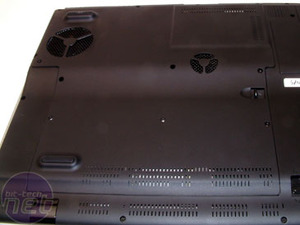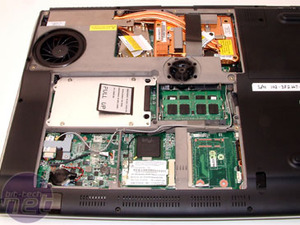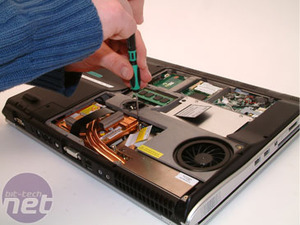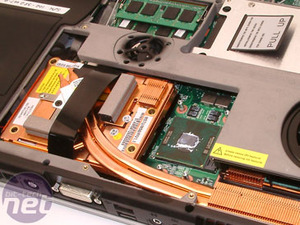Components
Although dual-core processors are still yet to show their prowess in every application, if you’re buying a notebook to last you a couple of years, going dual makes a lot of sense. This is particularly true of a system like the Xtreme CTX, which may be primarily intended to be a gaming champ, but is also meant to excel in a whole lot more besides. The Intel Core Duo T2600 is about the best option currently available for a notebook. As well as the Pentium M being a pretty darned tasty gaming CPU, having two of them on tap means the Rock is ready to handle your everyday media encoding tasks with gusto, and the two processors make it extremely responsive as well in everyday use.The other key feature, as we mentioned at the beginning of this review, is the ATi Mobility Radeon X1800XT graphics, a brand new chip from the Red Team. This isn’t going to leave you far behind a desktop system, as the mobile version of R520 still has 16 pixel shader pipelines, 8 vertex shaders, and a 550MHz core clock. Even the memory runs at 650MHz for an effective 1300MHz. Nvidia fanboys can choose GeForce Go 7800GTX instead, although there’s hardly any difference between the two in performance, and Rock charges the same for either. Whichever you go for, you’ll be able to use the excellent wide aspect WUXGA X-Glass TFT to its fullest. The version we were sent for review had a native 1,920 x 1,200 resolution, which you’ll actually be able to take advantage of with this notebook’s serious graphics grunt. We found 1,600 x 1,200 gaming was not an impossibility, although few titles support the 1,920-pixel wide aspect resolution, barring the very cool Tomb Raider Legend.




Although a 100GB hard disk may be a little on the small side for a desktop PC, it should be sufficient for plenty of game installs and an extensive collection of music and video files, plus lots of apps. There are other options up to 160GB available from Rock, but these are 5,400rpm so won’t be as quick. The chassis has room for a second disk, which you can specify at the time of manufacture. Fitting your own means undoing no less than 11 screws to open the chassis, which is clearly not intended for end-user upgrades, but it can be done nonetheless. The Sony DW-Q58A dual-layer DVD-RW, however, is the only option for this notebook. This offers healthy 4x dual-layer +R and –R burning, plus 8x single-layer.
The Rock has all the usual connectivity options. There’s an SD, MMC and MemoryStick reader on the right, beneath the single CardBlus slot. Headphone and microphone, FireWire, and two USB 2 ports can also be found on this side of the chassis. Line in and S/PDIF are located at the back, alongside two more USB 2 ports, DVI, S-Video, LAN and modem connections. A TV aerial socket is also lurking round the rear for use with the optional TV tuner, as well as a 9-pin serial port, presumably just in case you have an old mouse lying around. There’s even a webcam nestling in the centre of the top bezel, if you fancy trying out Skype 2’s video calling capabilities.
Styling
Despite its size and weight, the Rock is at least attractively wedge-shaped and feels reasonably solid. An LED display on the front tells you the time when the system is on, and has buttons to give you access to the optical drive when the system is otherwise powered down. With such a large form factor, there’s plenty of space for a full-sized keyboard, and the action is reasonably crisp, making typing comfortable. The X-Glass screen is another high point. Aside from the huge resolution and healthy 17in diagonal, this panel incorporates an anti-glare filter rather than the more usual diffuser. Sony’s X-black system and Dell’s TrueLife use the same technology. The result is a sharper, brighter image with better contrast, ideal for multimedia and games.Being a notebook, the Rock is much quieter than a desktop, but it isn’t exactly silent. Once you’ve got its juices flowing with a few minutes of gaming or some heavier processing tasks, whiney fans start to kick in. This won’t disturb you if you’re listening to the system’s reasonably powerful speakers, but it gets a bit annoying in an otherwise silent room. It’s par for the course with many power notebooks, with meaty components to keep cool, but we could still live without it.

MSI MPG Velox 100R Chassis Review
October 14 2021 | 15:04









Want to comment? Please log in.